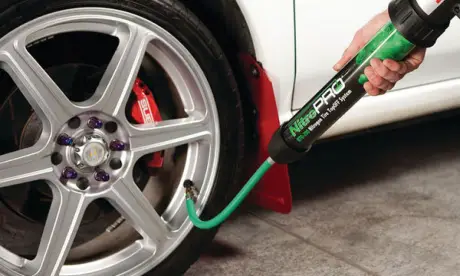
Each day when you cruise along in your vehicle, it is not the tires that carry you to the destination, but it's what is inside the tire that does the job. We usually use the standard compressed air from the auto repair shop or the gas station, but nitrogen tire inflation has become a pretty common practice these days.
Using nitrogen instead of air is not a new idea because this technology has been used in airplanes and Nascar racing vehicles for many years. For the consumers, this particular idea is relatively new, but there are certain benefits of nitrogen in tires - why and where, which include maximizing the tire pressure, extending the tire's life, and reducing tire corrosion.
Difference between nitrogen and regular air
When we understand the science behind compressed air and nitrogen, it can make us realize why nitrogen is a much better option as compared to regular air when it is about tire inflation. The standard tires are inflated with air which is already 78% of nitrogen, and the percentage is the same as the air that we happen to breathe.
When we use high-purity nitrogen in the tires, it doesn't support any moisture, which clearly means that the water molecules are not carried by it, just like the normal air. It is worth noting that the nitrogen molecules are about four times larger as compared to the oxygen molecules, so it can be challenging for these molecules to escape from the crevices of your tires.
Benefits of using nitrogen in tires
- You get a better MPG (miles per gallon)
Compared to compressed air, the nitrogen tires bleed pressure a lot slower, so you can get better mileage. Maintained tire pressure has its own importance for gas mileage and tire wear because the low pressure may not always seem under-inflated.
- You have a longer tire life
When the tire is inflated correctly, it wears slower. Pressure isn't lost quickly in a nitrogen-filled tire, which clearly means that you can get a much longer tire life.
- Oxidation gets blocked
Oxidation is caused by oxygen, and it can make the rubber brittle and can be dangerous, as it can boost the chances of a blow-out. When there is nitrogen in the tire, it blocks the internal rubber oxidation.
- Nitrogen can be a green alternative
Nitrogen can potentially be a green alternative because the nitrogen-filled tires are able to maintain the correct pressure, reduce emissions, get a better gas mileage and have a longer tire life. Therefore, the demand for the tires could decrease, which means that the use of natural resources will automatically be decreased.
Summary
There is 78% nitrogen in the earth's atmosphere, and when we fill the car tires with compressed air, it already has a lot of nitrogen in them. Nitrogen is hardly a consideration for an average car, but there are certain benefits of nitrogen in tires - why and where? The tires are mainly used in those vehicles that operate in hazardous areas where there is a risk of fire and in off-highway vehicles where the tires are stressed and happen to operate at their maximum load.
Same articles

Understanding Vehicle Inspection and Verification Services: Why They Matter for Every Driver
GuidesVehicle inspection and verification services are an essential but often overlooked part of keeping roads safe and cars legally compliant. Most people only think about inspections when it’s...
KLIFEX Brand Overview: High-Quality Automotive Repair Kits for Affordable Repairs
GuidesThe automotive aftermarket has long needed solutions that combine reliability, durability, and affordability. Many car enthusiasts and services are looking for a way...
Fast, Reliable Vehicle Emissions & Inspection Services Made Simple
GuidesFast, reliable emissions and inspection services are essential for keeping vehicles road-ready, compliant with environmental regulations, and safe for daily driving. If you’re looking for quick...

